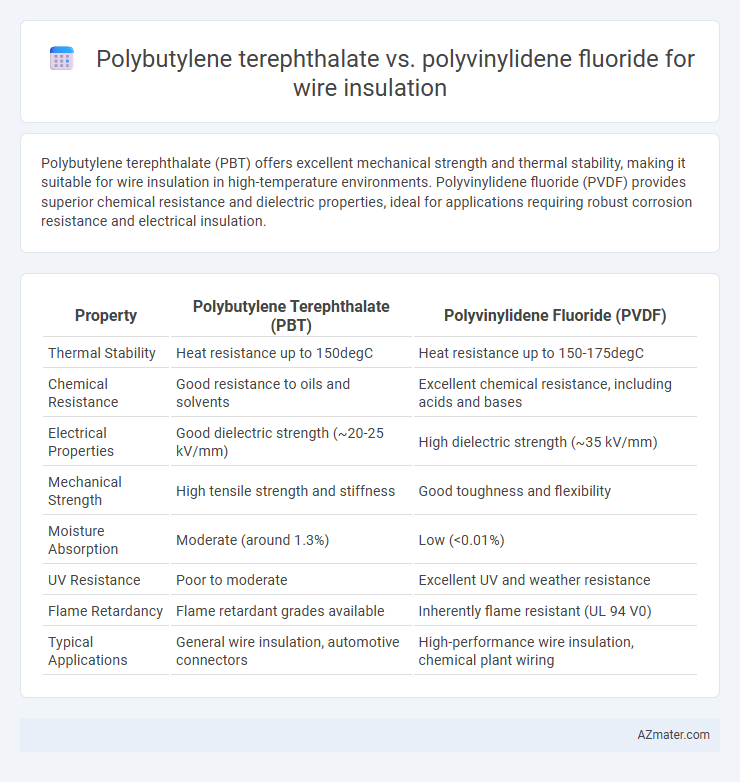Polybutylene terephthalate (PBT) offers excellent mechanical strength and thermal stability, making it suitable for wire insulation in high-temperature environments. Polyvinylidene fluoride (PVDF) provides superior chemical resistance and dielectric properties, ideal for applications requiring robust corrosion resistance and electrical insulation.
Table of Comparison
| Property | Polybutylene Terephthalate (PBT) | Polyvinylidene Fluoride (PVDF) |
|---|---|---|
| Thermal Stability | Heat resistance up to 150degC | Heat resistance up to 150-175degC |
| Chemical Resistance | Good resistance to oils and solvents | Excellent chemical resistance, including acids and bases |
| Electrical Properties | Good dielectric strength (~20-25 kV/mm) | High dielectric strength (~35 kV/mm) |
| Mechanical Strength | High tensile strength and stiffness | Good toughness and flexibility |
| Moisture Absorption | Moderate (around 1.3%) | Low (<0.01%) |
| UV Resistance | Poor to moderate | Excellent UV and weather resistance |
| Flame Retardancy | Flame retardant grades available | Inherently flame resistant (UL 94 V0) |
| Typical Applications | General wire insulation, automotive connectors | High-performance wire insulation, chemical plant wiring |
Introduction to Wire Insulation Materials
Polybutylene terephthalate (PBT) and polyvinylidene fluoride (PVDF) are prominent materials in wire insulation due to their distinct thermal and chemical properties. PBT offers excellent electrical insulation, high dimensional stability, and resistance to abrasion, making it suitable for general application wires. PVDF provides superior chemical resistance, high dielectric strength, and exceptional thermal stability, ideal for harsh environments and specialized industrial wiring.
Overview of Polybutylene Terephthalate (PBT)
Polybutylene Terephthalate (PBT) is a thermoplastic polyester known for its high mechanical strength, excellent electrical insulation properties, and resistance to chemicals and heat, making it ideal for wire insulation applications. It provides superior dimensional stability and low moisture absorption compared to many other polymers, enhancing performance in demanding environments. PBT's balance of rigidity and flexibility ensures durability in wire insulation, especially where thermal resistance and electrical safety are critical.
Overview of Polyvinylidene Fluoride (PVDF)
Polyvinylidene fluoride (PVDF) is a high-performance fluoropolymer widely used for wire insulation due to its excellent chemical resistance, thermal stability, and electrical properties. PVDF operates effectively in temperatures ranging from -40degC to 150degC, making it suitable for harsh environments and applications requiring long-term durability. Its inherent resistance to UV radiation and flame retardancy enhances safety and longevity in wire insulation compared to polybutylene terephthalate (PBT).
Mechanical Properties Comparison
Polybutylene terephthalate (PBT) offers excellent tensile strength and impact resistance, making it suitable for durable wire insulation under mechanical stress. Polyvinylidene fluoride (PVDF) exhibits superior flexibility and higher abrasion resistance, enhancing insulation longevity in dynamic or high-flex environments. PBT generally outperforms PVDF in stiffness and dimensional stability, while PVDF excels in chemical resistance and resistance to deformation under prolonged mechanical strain.
Thermal Stability and Heat Resistance
Polybutylene terephthalate (PBT) offers good thermal stability with a melting point around 223degC, making it suitable for wire insulation in moderate heat environments. Polyvinylidene fluoride (PVDF) exhibits superior heat resistance and thermal stability, with a melting point near 177degC but maintains structural integrity at temperatures up to 150degC for extended periods, outperforming PBT in prolonged high-temperature applications. PVDF's excellent chemical resistance and low thermal degradation rate make it ideal for high-performance wire insulation requiring durability under harsh thermal conditions.
Electrical Insulation Performance
Polybutylene terephthalate (PBT) offers excellent electrical insulation properties with a dielectric strength typically around 18-20 kV/mm, making it suitable for moderate voltage applications in wire insulation. Polyvinylidene fluoride (PVDF) provides superior electrical insulation, exhibiting dielectric strengths up to 35 kV/mm and enhanced resistance to electrical tracking and arc discharge, ideal for high-performance and high-voltage environments. The inherent chemical stability and low dielectric constant of PVDF contribute to its advantage in maintaining insulation integrity under harsh conditions compared to PBT.
Chemical and Environmental Resistance
Polyvinylidene fluoride (PVDF) exhibits superior chemical resistance compared to Polybutylene terephthalate (PBT), withstanding aggressive solvents, acids, and bases, making it ideal for harsh industrial environments. PVDF's low permeability and excellent UV resistance enhance its durability in outdoor applications, whereas PBT may degrade under prolonged chemical exposure and UV light. Environmentally, PVDF is more stable and less prone to hydrolysis, ensuring longer service life for wire insulation in chemically demanding and variable climate conditions.
Flexibility and Processability
Polybutylene terephthalate (PBT) offers excellent dimensional stability and moderate flexibility, making it suitable for wire insulation requiring rigidity and resistance to mechanical stress, although it is less flexible compared to polyvinylidene fluoride (PVDF). PVDF excels in flexibility and chemical resistance, providing superior processability in extrusion and molding processes, which enhances its performance in dynamic wire insulation applications. The choice between PBT and PVDF depends on the balance between mechanical robustness and the need for high flexibility and easy processing in wire insulation manufacturing.
Cost Efficiency and Market Availability
Polybutylene terephthalate (PBT) offers superior cost efficiency compared to polyvinylidene fluoride (PVDF) due to its lower raw material and processing expenses, making it a preferred choice for large-scale wire insulation projects. PBT also benefits from widespread market availability, with extensive global supply chains ensuring consistent access and competitive pricing. In contrast, PVDF, while providing excellent chemical resistance and thermal stability, commands a higher price point and faces limited availability in certain regions, affecting its adoption in cost-sensitive applications.
Application Suitability and Industry Use Cases
Polybutylene terephthalate (PBT) is favored for wire insulation in automotive and consumer electronics due to its excellent dimensional stability, chemical resistance, and good electrical properties at moderate temperatures. Polyvinylidene fluoride (PVDF) excels in high-performance industrial applications requiring superior chemical resistance, UV stability, and temperature tolerance up to 150degC, making it ideal for aerospace, chemical processing, and medical device wiring. PBT is commonly used where cost efficiency and mechanical strength are priorities, while PVDF is selected for critical environments demanding stringent safety and durability standards.

Infographic: Polybutylene terephthalate vs Polyvinylidene fluoride for Wire insulation
 azmater.com
azmater.com